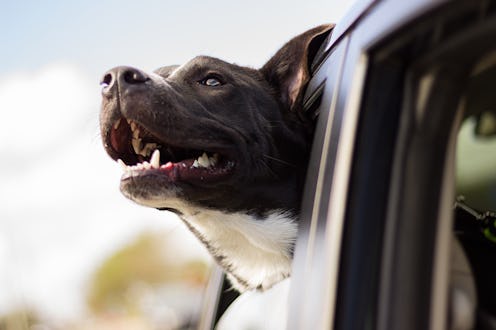Life
What You Need To Know About Dogs & Heatstroke

While the summer time might be the most exciting months to be a dog owner, it's a dangerous time to be a dog. The extreme heat can have damaging and fatal effects on a dog's health and well-being, which is why it's imperative to know and understand how to protect your dog from heatstroke. Without a voice to speak up, it's up to the owner to err on the side of caution and pay close attention to their pet's noticeable vitals. But even with most cautious and attentive owners, it's impossible to be sure of your dog's internal condition.
My dog is my shadow. He follows me around the house, and he follows me outside. When I'm sunbathing, all he wants is to lie right next to me — he's completely uninterested in the shade unless I'm in it. That said, I have to be extra careful with him in the summer. While he might seem content panting in the sun by my side, I can't rely on his senses to know when it's too hot for him. Our internal thermometers do not function on the same scale. The line between hot and heatstroke is very thin. Which is exactly why I have to take some serious precautions when letting him be my summer shadow.
I talked to veterinarian Dr. Jonathan Olsen at Mount Kisco Veterinary in Westchester, New York about how to protect your dog from heatstroke and how to recognize the early and more serious signs of it. Here's what he recommends:
Know Your Breed
Certain breeds of dogs are more susceptible to heatstroke. Flat-nosed breeds like Bulldogs, French Bulldogs, Pugs, Boston Terriers, Boxers and Shih Tzus have respiratory challenges simply due to their anatomy. Because it's more difficult for these breeds to breathe properly, it takes them a longer time to cool down — which can be especially dangerous when they're overheated. Similarly, dogs who are overweight or not accustomed to physical activity suffer from cooling challenges. It's more difficult for these types of dogs to thermoregulate so it's imperative to make sure that they have constant access to shade and cool water and are never encouraged to over-exert themselves.
Know Your Environment
You've probably heard about the dangers of leaving a dog in a hot car. But it doesn't have to be a significantly hot day for your dog to overheat. Even if it's only 70 degrees outside, it only takes an hour for your dog to heat up over 40 degrees inside of a closed small area. That said, never leave your dog in the car during the warm months without the engine on and the AC blasting. Doghouses, small un-ventilated rooms, and shade-less yards are also danger-zones for dogs of all breeds in the warm months.
Know How To Adjust
On the hottest days, your dog will still rely on their walks — not just to do their business, but also to for exercise and fresh air. You can still walk your dog in the summer, you just have to adjust your usual routine. Try to avoid walking in the hottest hours of the day. Walk early and late and always check the pavement with your hand to make sure it's suitable for your dog's paws. Err to the shady side of the street, shorten the distance, and stop frequently for water.
Know The Early Signs
If your dog is panting heavily and acting more lethargic than usual — it's not unusual for dogs to feel a little lazy in the summer — they might be showing early signs of heatstroke. Other subtle signs include difficulty moving due to muscle cramps and discomfort. If you notice any of these signs in your dog, offer them cool (not icy) water and make sure they're completely in the shade. If they refuse the water, rather than forcing it on them, wet their paw pads, neck, groin, and armpits and put them in front of a fan. The fan will help them cool down faster.
Know When To Go To The Vet
Certain levels of heatstroke are irreparable. So if you're concerned your dog has been exposed to heat for too long and is having trouble regulating their temperature, take them to your local vet. The more serious and permanent signs of heatstroke include seizures, collapse and being unresponsive. If the brain temperature reaches 105 degrees (average healthy dog temperatures range between 99.5-102.5 degrees) there can be prolonged damage to the brain and lead to a fatality.
Enjoy your summer, but remember: safety first!